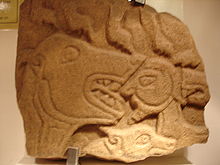Rosemarkie sculpture fragments
- Rosemarkie sculpture fragments
-

The so-called Daniel Stone.
The Rosemarkie sculpture fragments are the Pictish slabs and stone fragments other than the main Rosemarkie Stone which have been discovered in Rosemarkie, on the Black Isle of Easter Ross. There are fourteen in all. Perhaps the most widely known is the so-called Daniel Stone. The latter is so named because of the tendency among scholars and enthusiasts of Pictish art to give every Pictish stone a christian interpretation. In this case, the depiction of a man's head at the jaws of a wolf-like beast is supposed to depict the Old Testament story of Daniel in the Lion's Den. However, the stones are all of likely christian origin, and share a similar style with the art of Iona. Some of them may have been of funerary purpose, as coffin lids, while others may have formed part of a larger stone. These stones are usually displayed in the Groam House Museum of Rosemarkie.
References
- Fraser, Iain, Ritchie, J.N.G., et al., Pictish Symbol Stones: An Illustrated Gazetteer, (Royal Commission on the Ancient and Historical Monuments of Scotland, 1999)
External links
| v · Pictish Stones of Ross |
|
|
|
|
Coordinates: 57°35′29″N 4°6′48″W / 57.59139°N 4.11333°W / 57.59139; -4.11333
Categories:
- Pictish art
- Pictish stones
- Archaeological sites in Highland (council area)
- United Kingdom archaeology stubs
- Scottish building and structure stubs
Wikimedia Foundation.
2010.
Look at other dictionaries:
Rosemarkie — ( gd. Ros Maircnidh) (NGR: oscoor|NH736576|NH 736 576) is a village on the south coast of the Black Isle peninsula in northern Scotland, a quarter of a mile east of the town of Fortrose. The pair make up the Royal Burgh Of Fortrose and Rosemarkie … Wikipedia
Clach a' Charridh — Reverse, landward side. This is a 19th century illustration. Clach a Charridh, Landwar … Wikipedia
Clach a' Mheirlich — Picture of the stone, taken in July 2006. The Clach a Mheirlich (literally, the Thief s stone ) or Rosskeen Stone is a standing stone in a field near Rosskeen, Easter Ross, Scotland. The stone itself is Bronze Age in origin, but has on it three… … Wikipedia
Clach Biorach — A distance photograph of Clach Biorach taken in July 2006. The Clach Biorach (in English, Sharp Stone ) is a three metre Standing Stone located a 1/4 mile north west of the village of Edderton in Easter Ross. It dates to the Bronze Age, but two… … Wikipedia
Clach an Tiompain — (The Eagle Stone) Clach an Tiompain, Strathpeffer Material Blue gneiss Created 500 700AD Pres … Wikipedia
Nigg Stone — The reverse or secular side of the stone in a 19th century illustration, minus the top section … Wikipedia
Dingwall Stone — The Dingwall Stone is a Class I Pictish stone located in Dingwall, Easter Ross. It is thought by some to be of Bronze Age origin, and contains several cup and ring marks alleged to date from that period. If it had been used in the Bronze Age, the … Wikipedia
Pierres Pictes de Ross — Les pierres pictes de Ross sont un ensemble de pierres travaillées par les Pictes, confédération de tribus présente dans le nord et le sud de l Écosse de l époque romaine au Xe siècle. Un nombre important de ces pierres peut être trouvé dans … Wikipédia en Français
Pierres pictes de Ross — Les pierres pictes de Ross sont un ensemble de pierres travaillées par les Pictes, confédération de tribus présente dans le nord et le sud de l Écosse de l époque romaine au Xe siècle. Un nombre important de ces pierres peut être trouvé dans … Wikipédia en Français
Dunfermline — DUNFERMLINE, a royal burgh, and parish, in the district of Dunfermline, county of Fife; including the villages of Charlestown, Crossford, Halbeath, Limekilns, Mastertown, Patiemuir, North Queensferry, and part of Crossgates; and containing… … A Topographical dictionary of Scotland

